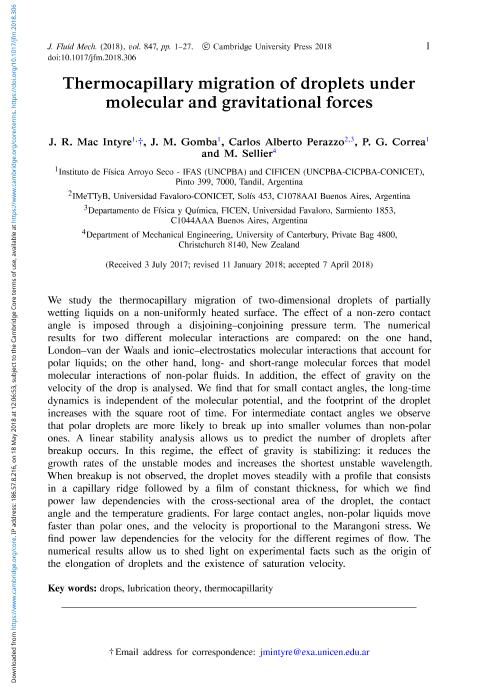Mostrar el registro sencillo del ítem
dc.contributor.author
Mac Intyre, Jonatan Raúl

dc.contributor.author
Gomba, Juan Manuel

dc.contributor.author
Perazzo, Carlos Alberto

dc.contributor.author
Correa, Pablo Germán

dc.contributor.author
Sellier, M.
dc.date.available
2019-10-17T17:18:15Z
dc.date.issued
2018-07
dc.identifier.citation
Mac Intyre, Jonatan Raúl; Gomba, Juan Manuel; Perazzo, Carlos Alberto; Correa, Pablo Germán; Sellier, M.; Thermocapillary migration of droplets under molecular and gravitational forces; Cambridge University Press; Journal of Fluid Mechanics; 847; 7-2018; 1-27
dc.identifier.issn
0022-1120
dc.identifier.uri
http://hdl.handle.net/11336/86162
dc.description.abstract
We study the thermocapillary migration of two-dimensional droplets of partially wetting liquids on a non-uniformly heated surface. The effect of a non-zero contact angle is imposed through a disjoining-conjoining pressure term. The numerical results for two different molecular interactions are compared: on the one hand, London-van der Waals and ionic-electrostatics molecular interactions that account for polar liquids; on the other hand, long-and short-range molecular forces that model molecular interactions of non-polar fluids. In addition, the effect of gravity on the velocity of the drop is analysed. We find that for small contact angles, the long-Time dynamics is independent of the molecular potential, and the footprint of the droplet increases with the square root of time. For intermediate contact angles we observe that polar droplets are more likely to break up into smaller volumes than non-polar ones. A linear stability analysis allows us to predict the number of droplets after breakup occurs. In this regime, the effect of gravity is stabilizing: it reduces the growth rates of the unstable modes and increases the shortest unstable wavelength. When breakup is not observed, the droplet moves steadily with a profile that consists in a capillary ridge followed by a film of constant thickness, for which we find power law dependencies with the cross-sectional area of the droplet, the contact angle and the temperature gradients. For large contact angles, non-polar liquids move faster than polar ones, and the velocity is proportional to the Marangoni stress. We find power law dependencies for the velocity for the different regimes of flow. The numerical results allow us to shed light on experimental facts such as the origin of the elongation of droplets and the existence of saturation velocity.
dc.format
application/pdf
dc.language.iso
eng
dc.publisher
Cambridge University Press

dc.rights
info:eu-repo/semantics/openAccess
dc.rights.uri
https://creativecommons.org/licenses/by-nc-sa/2.5/ar/
dc.subject
DROPS
dc.subject
LUBRICATION THEORY
dc.subject
THERMOCAPILLARITY
dc.subject.classification
Física de los Fluidos y Plasma

dc.subject.classification
Ciencias Físicas

dc.subject.classification
CIENCIAS NATURALES Y EXACTAS

dc.title
Thermocapillary migration of droplets under molecular and gravitational forces
dc.type
info:eu-repo/semantics/article
dc.type
info:ar-repo/semantics/artículo
dc.type
info:eu-repo/semantics/publishedVersion
dc.date.updated
2019-10-16T15:09:07Z
dc.journal.volume
847
dc.journal.pagination
1-27
dc.journal.pais
Reino Unido

dc.journal.ciudad
Cambridge
dc.description.fil
Fil: Mac Intyre, Jonatan Raúl. Consejo Nacional de Investigaciones Científicas y Técnicas. Centro Científico Tecnológico Conicet - Santa Fe. Instituto de Desarrollo Tecnológico para la Industria Química. Universidad Nacional del Litoral. Instituto de Desarrollo Tecnológico para la Industria Química; Argentina
dc.description.fil
Fil: Gomba, Juan Manuel. Universidad Nacional del Centro de la Provincia de Buenos Aires; Argentina
dc.description.fil
Fil: Perazzo, Carlos Alberto. Universidad Favaloro; Argentina
dc.description.fil
Fil: Correa, Pablo Germán. Universidad Nacional del Centro de la Provincia de Buenos Aires; Argentina
dc.description.fil
Fil: Sellier, M.. University of Canterbury; Nueva Zelanda
dc.journal.title
Journal of Fluid Mechanics

dc.relation.alternativeid
info:eu-repo/semantics/altIdentifier/url/https://www.cambridge.org/core/product/identifier/S0022112018003063/type/journal_article
dc.relation.alternativeid
info:eu-repo/semantics/altIdentifier/doi/http://dx.doi.org/10.1017/jfm.2018.306
Archivos asociados
